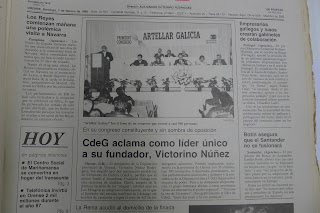Sandiás Local Council (Ourense - Galicia - Spain)
Sandiás is situated in ¨A Limia¨ (a region located in the South of the province of Ourense). It has got an extension of 53 km2, a great part of those are drained fields from the Antela lagoon.
This is an agricultural area. Potatoes are the most important crop. Sand extractions are also important for local development.
History:
The first sign of earlier inhabitants are the remains of lake dwellings (palafittes) in the Antela lagoon.Due to the Roman milestones findings, it is known that a Roman road (Roman road XVIII or Via Nova) passed through the area, there is also a Roman mansion in the village of Sandiás. In the Middle Ages, its castle witnessed the struggle for the secession of Portugal, fights among the nobles and peasants riots. Portuguese and Southern Spanish pilgrims (Via the “Silver road”) went through Sandiás on their way to Santiago de Compostela (St. James’ way).
¨Europe was made on the pilgrim road to compostela¨
Goethe
Most important monuments:
St. Stephen´s church
An example of the Galician renaissance art. Built before 1520. The frontpiece belongs to the ¨manuelino¨ style (portuguese style, rare in Galicia). The altarpiece was built in 1603 by the famous Galician sculptor Bartolome de Moure.
The tower of the old castle
Probably built in the first half of the XII century (although some legends say it was built in the IX century), it was located over a ¨castro¨ (celtic settlement).
It participated in the Portugal secession wars (XII). In 1386 it was assaulted by the duke of Lancaster, pretender to the Castilla crown. In the XV century it was demolished by a popular riot, and rebuilt later.
It was a meeting point for troops in the wars with Portugal in the XVIII century.
The Antela Lagoon
The Antela lagoon, located in this geographical setting, was one of the most important wetland areas in Europe.
Until its drainage approximately 50 years ago, it was always the heart of ¨A Limia¨, the surrounding district. It was artificially drained and it is being recovered at present. It was the most important lagoon in Spain, measuring 7 km long and 6 km wide. It had an average depth of 0, 60 m., reaching 3 m. in some places.
It has innumerable legends, some of which talk about the sinking of the town of Antioquia as punishment for adoring cockerels, or about mosquitoes that haunted King Arthur and his knights.
Its first inhabitants lived in lake dwellings, which were archaelogically as important as those from the Swiss lakes.
Draining actions were innumerable until 1958. The Romans built a channel of 26 km long and 17 m wide. The modern channel follows the original Roman planning.
Thousands of aquatic birds were part of its rich fauna. Nowadays that fauna has reappeared in the abandoned lagoons because of sand extractions



Comentarios
Publicar un comentario